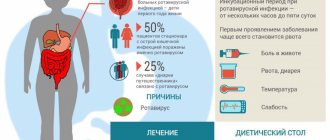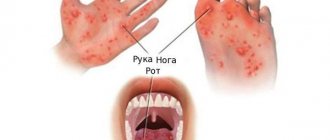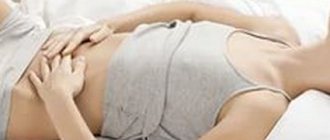Dolichocolon is the most common anomaly of the structure of the large intestine, consisting in the elongation of one or more of its structural elements; as a rule, the disproportion is found in the colon or its individual segments. The term “dolichocolon” is of ancient Greek origin and literally reflects the essence of the condition: “long (dolicho-) colon (-colon).” In some sources, mainly domestic, dolichosigma (lengthening of the sigmoid, terminal segment of the colon) and dolichotransversum (lengthening of the transverse colon) are sometimes considered as a special case.
Dolichocolon has significant differences from other anatomical anomalies of the lower intestine, in particular, from its expansion (see “Megacolon”) or deficiency of innervation (see Hirschsprung’s disease). It should also be emphasized that dolichocolon is widespread compared to similar conditions: most estimates indicate that approximately every third child in the modern world is born with an elongated colon. If we add acquired forms to this, then the presence of this anomaly will have to be assumed in at least half of the general adult population. However, such estimates vary widely, since it is very difficult to reliably estimate the actual prevalence of dolichocolon: many asymptomatic or minimally symptomatic cases remain, apparently, undiagnosed, while in other situations, elongation of the large intestine is combined with its dilatation or other, more serious pathology; In addition, to this day there is no common understanding of what anatomical parameters of the large intestine should be considered normative.
The exact reasons for the formation of dolichocolon remain unknown to this day. Given the predominance of congenital forms, the dominant role of the hereditary factor was previously assumed, but in recent decades this anomaly has increasingly been associated with various harmful factors acting at the stage of intrauterine development: infections suffered by a pregnant woman (bacterial, viral, protozoal), intoxication, radiation exposure, environmental and occupational hazards, destructive addictions to psychoactive substances.
Acquired dolichocolon can be caused by an unbalanced diet with a predominance of plant fiber, irregular bowel movements (regardless of the reasons), abdominal surgical interventions, injuries, dyskinesias, and obstructive problems in the lower intestines.
As stated above, in some cases, dolichocolon is a practically asymptomatic anomaly that is discovered accidentally during an X-ray or tomographic examination for another reason. Classic symptoms caused by lengthening of the large intestine include a tendency to constipation, pain or heaviness in the lower abdomen, a feeling of incomplete emptying after bowel movements, flatulence, and various dyspeptic symptoms.
In the most severe cases, intestinal obstruction may occur due to volvulus or intussusception, perforation of the walls of an overcrowded intestine with the development of peritonitis, and other life-threatening conditions.
If dolichocolon is suspected, a plain radiography of the abdominal organs, X-ray contrast irrigoscopy, and colonoscopy are prescribed. Laboratory tests of blood, stool and urine are performed as necessary. Differential diagnosis from symptomatically similar conditions or identification of concomitant pathology (most often megacolon or Hirschsprung's disease) may require a biopsy.
In asymptomatic cases, treatment is not prescribed; in asymptomatic cases (recurrent constipation), the diet, fluid intake and bowel movements are adjusted. In the presence of a more pronounced clinical picture, they resort to peristalsis stimulants, laxatives (depending on the characteristics of the individual case, preference may be given to oral or local agents, suppositories, enemas, etc., or a combination thereof), as well as physiotherapeutic methods. The ineffectiveness of the measures taken, the rapid deterioration of intestinal functions with the addition of threatening complications requires a decision on the issue of surgical intervention (sometimes urgent, urgent or even emergency), the volume and technique of which are chosen, again, on a strictly individual basis, taking into account all diagnosed factors. Needless to say, it is better to avoid such situations: timely seeking help and following the instructions received in the vast majority of cases provides fairly effective control of the condition and functioning of the intestines.
Symptoms of pathology
Often the disease occurs without any symptoms. Against the background of such an asymptomatic course, pathological complications may suddenly develop, which will require surgical intervention. Severe symptoms of intestinal dolichocolon in children and adults:
- periodic abdominal pain, which intensifies with physical activity;
- chronic constipation;
- after bowel movement - a feeling of fullness;
- pain in the anus and abdomen during bowel movements;
- loss of appetite.
Pathological complications such as intestinal volvulus and obstruction may develop.
Treatment
Asymptomatic dolichocolon is not considered a disease and does not require treatment. For chronic constipation, therapeutic measures restore bowel movement and improve well-being.
Treatment should be comprehensive and step-by-step. To stimulate your intestines, try to move more: do morning exercises, walk, sign up for a pool or gym.
Diet
Adjust your diet and eating habits.
Principles of nutrition
- Eat regularly. Long breaks in eating increase the risk of complications. It is no coincidence that volvulus is called “the disease of a hungry man.”
- Eat food in a calm environment, without rushing.
- Maintain drinking regime. For normal bowel function, 1.5-2 liters of fluid per day is required, including first courses, vegetables, and fruits.
- Include foods rich in dietary fiber in your diet.
- Avoid foods that are too rough. Increased peristalsis can cause intestinal obstruction.
- Eliminate foods that increase the formation of gases in the intestines. Flatulence causes abdominal pain.
- Any methods of culinary processing of products are allowed.
Grocery list
| Recommended | Not recommended |
|
|
Adjust the list depending on individual preferences and food intolerances.
Medicines
- Laxatives - treatment begins with preparations based on dietary fiber (Psyllium, wheat bran, Mucofalk). If ineffective, osmotic agents are prescribed: Macrogol (polyethylene glycol) and Duphalac (lactulose). Irritating drugs (Bisacodyl, Senade) are used to a limited extent, as they are addictive.
- Antispasmodics - reduce the tone of intestinal smooth muscles, relieve painful spasms (Papaverine hydrochloride, Duspatalin, No-shpa).
- Defoamers are drugs to combat flatulence, prescribed for bloating (Espumizan, Sab Simplex).
- Eubiotics (probiotics) are drugs for correcting the microflora of the colon, prescribed for concomitant dysbacteriosis (Linex, Helac Forte, Bifiliz).
Be sure to read:
Endoscopic methods for examining the intestine: description and preparation
Physiotherapy
Physiotherapy methods stimulate intestinal motor activity.
- acupuncture;
- cutaneous and rectal electromyostimulation;
- laser therapy;
- acupuncture.
Surgery
If conservative treatment is ineffective or there is a significant deterioration in health, surgery is recommended.
Basic techniques:
- subtotal resection of the colon - removal of all parts of the colon except the lower part of the sigmoid segment;
- segmental resection of the colon - excision of a pathologically changed section;
- colectomy – removal of the entire colon.
In case of intestinal obstruction, endoscopic detorsion is performed - straightening the volvulus. If the procedure is ineffective, a laparotomy is performed, the intussusception or volvulus is removed, the knot from the loops is untangled, and the viability of the intestine is assessed. In case of necrosis, the affected area is removed.
Diagnostic measures
Primary diagnosis involves interviewing the patient and palpating the intestine through the anterior abdominal wall. The doctor also prescribes additional examination methods - these are:
- rectoscopy;
- colonoscopy;
- ultrasound examination of the pelvic organs;
- irrigoscopy;
- general blood analysis;
- stool occult blood test.
Signs of dolichocolon are quite well visualized on x-ray, so there is often no need to prescribe other research methods.
How to treat dolichocolon
If the pathology is asymptomatic, then no special treatment is prescribed to the patient. He is periodically examined for early detection of complications, and his diet is adjusted. Diet principles for the diagnosis of dolichocolon:
- eating large quantities of fresh vegetables and fruits (they can also be baked in the oven or stewed);
- refusal of sweets, baked goods made from wheat flour, rice and potatoes;
- consumption of milk and fermented milk products;
- exclusion of carbonated and alcoholic drinks.
In general, nutrition for dolichocolon disease consists of eating sparing and high-calorie foods.
How to treat intestinal dolichocolon with medications:
- laxatives are prescribed, but only if the patient is bothered by chronic constipation;
- a course of vitamin therapy is required - a complex of vitamins is selected by the attending physician;
- analgesics and antispasmodics are indicated only in the presence of severe pain in the intestines.
Basic therapy can be supplemented with herbal remedies, physical therapy, and some physiotherapeutic procedures. To speed up bowel movements during prolonged constipation, siphon enemas are prescribed.
If there is no effect from drug therapy, treatment of dolichocolon in adults is carried out surgically. Laparoscopic intervention is more preferable, which is characterized by a low number of complications and a short rehabilitation period. The consequences of surgery for dolichocolon, which is performed using the abdominal method, in some cases can be severe - from internal bleeding to intestinal obstruction.
After treatment, regardless of the chosen method, the patient must be registered at a dispensary, follow the recommended diet and undergo a follow-up examination at least once every 6 months. After a year, it is recommended to visit a doctor once a year.
Like
Social buttons
MAKE AN APPOINTMENT 8(495)304-30-40 TELEPHONE FOR INFORMATION 8(495)304-30-39 APPOINTMENT SCHEDULE
Surgical aspects of the treatment of patients with dolichocolon.
Dolichocolon (dolichocolon; dolicho- + Greek kolon large intestine) is a developmental anomaly, an unusually large length of the colon or its parts.
This problem is relevant, as it is often identified when patients complain of constipation [2, 14], and is also identified during urgent surgical interventions for acute strangulation intestinal obstruction against the background of volvulus, usually sigmoid, of the intestine with postoperative mortality up to 15% [ eleven]. However, at present there is no generally accepted standard for the length of the colon and its parts [1, 7].
To classify the disease, it is advisable to use the names of the anatomical parts of the colon. Based on this, it is customary to distinguish the following types of dolichocolon: total dolichocolon, subtotal dolichocolon, dolichosigma, dolichotransversum, left-sided and right-sided dolichocolon.
According to the clinical picture, dolichocolon can be divided into a disease without clinical manifestations, dolichocolon with impaired transit of intestinal contents; dolichocolon with the development of complications (acute strangulation intestinal obstruction) [1, 3, 10, 11, 18].
The diagnosis of dolichocolon is established on the basis of the clinical picture of the disease and must be confirmed by instrumental studies, such as irrigoscopy with double contrast, colonoscopy, functional examination of the pelvic floor muscles, proctography with straining, and, if necessary, supplemented by consultations with specialized specialists: neurologist, psychiatrist, endocrinologist [1, 5 ].
Treatment of patients with dolichocolon should be carried out individually and based on the obtained clinical and instrumental data of the individual patient. Patients diagnosed with the disease according to instrumental studies, but without clinical symptoms, do not require special treatment. They can prevent slow-transit constipation [1]. In this case, surgical treatment is not indicated.
Patients with clinical manifestations of dolichocolon are treated conservatively by a gastroenterologist.
In case of ineffectiveness of conservative therapy for instrumentally proven dolichocolon, accompanied by impaired transit through the colon, the possibility of surgical treatment may be considered. Although there are no clearly defined indications for surgical treatment of dolichocolon, some coloproctologists are inclined only to medicinal, symptomatic treatment [4, 6].
The indication for surgical intervention is the ineffectiveness of repeated courses of conservative therapy in cases of severe impairment of quality of life [1, 12, 15].
If patients have a history of intestinal obstruction, it is possible to assume a complicated form of dolichocolon. These patients should be fully examined and, after confirming the diagnosis, they should be offered elective surgical treatment, taking into account the risk of recurrent severe and life-threatening complications [1]. If complications of dolichocolon (volvulus, intussusception, nodulation) could not be avoided, then treatment is carried out in accordance with generally accepted surgical tactics for the treatment of acute mechanical intestinal obstruction. For intestinal volvulus, one of the treatment methods is endoscopic detorsion.
For a long time, the question of the scope of surgical intervention for dolichocolon remained controversial, suggesting that it should be limited only to resection of the sigmoid colon, megasigmoplication. However, these methods were ineffective. The best results [8, 9] of surgical treatment were obtained with more extensive resections: subtotal resection of the colon [1, 13] or colectomy with the formation of ileorectoanastomosis [10, 16].
Thus, when complicated dolichocolon is combined with constipation, the patient should be offered surgery in the form of subtotal colon resection or colectomy [1,10]. Surgical treatment should be carried out only after a complete examination of the patient and exclusion of other causes of constipation.
The management of patients with dolichocolon in the early postoperative period does not have any peculiarities and does not differ from the management of patients with the corresponding volume of surgical intervention for another pathology.
All patients with dolichocolon after surgical treatment are subject to dynamic monitoring by gastroenterologists and coloproctologists every 6 months during the first year, then with subsequent examination once a year [1]. The purpose of such periodic medical examinations is to evaluate the effectiveness of the surgical treatment performed. Identification of patients with worsening treatment results determines a group of people for anti-relapse measures. The postoperative mandatory examination plan must necessarily include studies to determine the transit time through the gastrointestinal tract.
The recurrence rate of constipation after colectomy during surgical treatment of dolichocolon with impaired transit through the colon reaches 10% [17]. The prospect of successful management of patients with diagnosed dolichocolon is the participation in the treatment of a multidisciplinary group of specialists with the involvement of a gastroenterologist and coloproctologist.
List of used literature.
1. Achkasov S.I. Anomalies of development and position of the large intestine (clinic, diagnosis, treatment). Diss. Doctor of Medical Sciences M., 2003, 297 p.
2. Karpukhin O. Yu., Shakurov A. F., Savushkina N. Yu. Diagnostic and therapeutic tactics for chronic colonic constipation. Practical Medicine, 2012, No. 8 (64).
3. Korolev L.F. Intestinal nodule formation. Surgery, 1966, N3, pp. 45-48.
4. Minushkin O.I., Elizavetina G.A. Laxatives in the treatment of constipation. Ter. arch. 1999; 4: 60-63.
5. Shelygin Yu.A., Blagodarny L.A. Handbook of coloproctology. M.: Litterra, 2012. 596 p.
6. Akerlund JE, Einarsson C. Effects of colectomy on bile composition, cholesterol saturation and cholesterol crystal formation in humans. Int J Colorectal Dis 2000; 4: 248–252.
7. Corman ML Colon and Rectal Surgery. Philadelphia: Lippincott, 1984. P.129-134.
8. Cordon PH, Nivatvongs S. Principles and practice of surgery for the colon, rectum and Anus. Second Edition. St Louis Missouri 1999; 994.
9. Faslh S., Hedlund H., Svaninger G. et al. Functional results after subtotal colectomy and caecorectal anastomosis. Ada ChirScand 1983; 149: 623–627.
10. Feng Y, Jianjiang L. Functional outcomes of two types of subtotal colectomy for slow-transit constipation: ileosigmoidal anastomosis and cecorectal anastomosis. Am J Surg 2008; 195: 73-77.
11. Grossman EM, Longo EW, Stratton MD, Virgo KS, Johnson FE Sigmoid volvulus in the department of veterans affairs medical centers. Dis. Colon Rectum, 2000; 43: 414-418
12. Jiang CQ, Qian Q, Liu ZS et al. Subtotal colectomy with antiperistaltic cecoproctostomy for selected patients with slow transit constipation-from Chinese report. Int J Colorectal Dis 2008; 23: 1251–1256.
13. Marchesi F., Sarli L., Percalli L. et al. Subtotal colectomy with antiperistaltic cecorectal anastomosis in the treatment of slow-transit constipation: long-term impact on quality of life. World J Surg 2007; 31: 8: 1658–1664.
14. Pfeifer J. Surgical options to treat constipation: A brief overview. Rozhl Chir., 2015; 94 (9): 349-61.
15. Pinedo G., Zarate AJ, Garcia E. et al. Laparoscopic total colectomy for colonic inertia: surgical and functional results. Surg Endosc 2009; 23:1:62-65.
16. Ripetti V., Caputo D., Greco S. et al. Is total colectomy the right choice in intractable slow-transit constipation? Surgery 2006; 140: 3: 435–440.
17. Riss S, Herbst F, Birsan T, Stift A. Postoperative course and long term follow up after colectomy for slow transit constipation—is surgery an appropriate approach? Colorectal Dis 2009; 11: 302-307.
18. The Large Intestine: Physiology, Pathophysiology, and Disease. Edited by SF Phillips, JH Pemberton, PG Shorter. New York, Mayo Foundation, 1991. P. 10.
Disease prevention
The prognosis for timely detection and adequate treatment of dolichocolon is favorable. But preventing a disease is easier than treating it. In order to prevent dolichocoline, the following recommendations should be followed:
- lead an active, mobile lifestyle;
- exercise regularly (at least morning exercises);
- maintain a proper diet;
- recover promptly from the urge to defecate.
More information about the disease, as well as the difference between dolichocolon and dolichosigma, can be found on the pages of our website.
Related services: Appointment with a proctologist Surgical operations
Causes of dolichosigma
Dolichosigma can be a congenital or acquired condition in which the sigmoid colon has 2-3 additional loops. The etiological cause of dolichosigma is unclear. It is assumed that congenital disorder of growth and fixation of the sigmoid colon may be associated with heredity; exposure to unfavorable environmental, physical, and chemical factors on the fetus; infectious diseases of the expectant mother, taking certain medications by the pregnant woman.
Acquired dolichosigma occurs as a result of digestive disorders associated with the processes of prolonged fermentation and putrefaction in the intestines. This usually affects people over 45-50 years of age who lead a sedentary lifestyle, are engaged in sedentary work, abuse meat and carbohydrates, and often experience stress. At the same time, some authors believe that dolichosigma is always a congenital anomaly, and digestive problems only cause the manifestation of clinical manifestations given the existing anatomical prerequisites.
To date, proctology has not resolved the question of whether dolichosigma should be considered a malformation of the colon or an individual variant of the norm. On the one hand, dolichosigma occurs in 15% of completely healthy children, which gives grounds to consider it a variant of the norm. On the other hand, elongation of the sigmoid colon is often accompanied by organic and functional disorders of the distal colon, which makes one think about a developmental anomaly. It is likely that dolichosigma is a kind of background for the development of clinical pathology.
Morphological examination of the intestinal walls in dolichosigma reveals structural disorders caused by intestinal stasis and chronic inflammation: sclerotic changes in the mesentery, hypertrophy of muscle fibers, myofibrosis, damage to the intramural nerve ganglia, degeneration of the mucous membrane. Thus, in the intestinal wall with dolichosigma, secondary degenerative changes take place, leading to disruption of its motor function.










